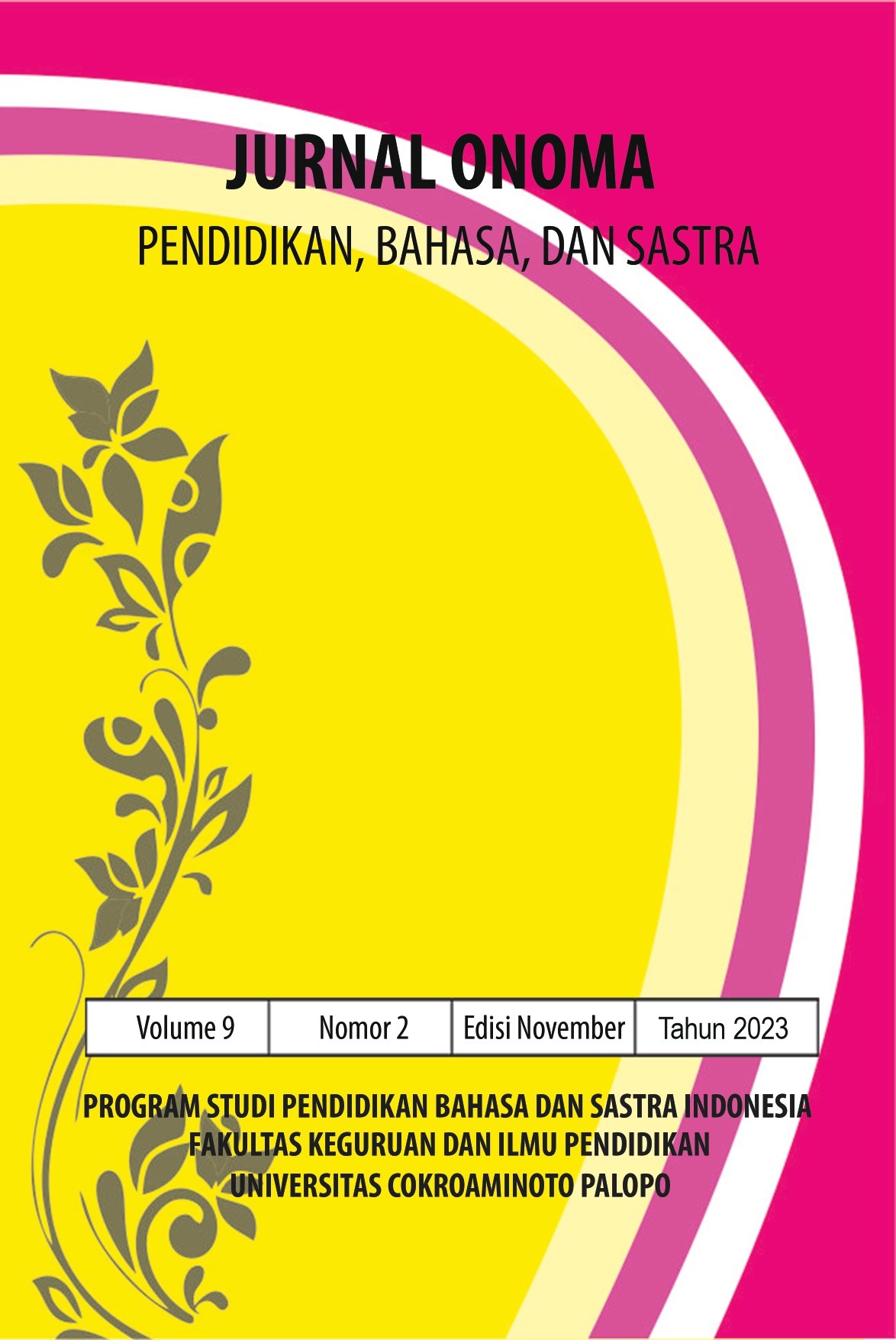Investigating Factors Affecting English Language Engagement among the Law Department Learners in Papua: An Empirical Analysis”
https://doi.org/10.30605/onoma.v9i2.2992
Keywords:
Factors, affecting, English Language Engagement, the Law Department Learners in PapuaAbstract
The objective of the study is to investigate the factors affecting English Language Engagement among the Law Department Learners in Papua. This study is qualitative by implementing a cross-sectional design to capture a snapshot of English language engagement among the Law Department Learners in Papua. A diverse sample of the Law Department Learners in Papua from multiple schools had been selected. The sample included learners from different grades, socio-economic backgrounds, and language proficiency levels in the Law Department Learners in Papua. Qualitative data from open-ended questions were subjected to thematic analysis to identify recurring patterns and themes related to intrinsic and extrinsic factors. This study confirms that conventional monotony in instructional materials and insufficient reading practice are the main factors that make the Law Department Learners in Papua lazy to learn English in the classroom. It is recommended to delve deeper into the identified factors of conventional monotony in instructional materials and insufficient reading practice as contributors to students' lack of motivation in learning English in the classroom.
Downloads
References
Abrouq, N. (2022). Factors Inhibiting the Development Process of Reflective Thinking through Journal Writing: A Literature Review. Journal of World Englishes and Educational Practices, 4(2), 70-79. DOI: https://doi.org/10.32996/jweep.2022.4.2.6
Ahmed, A., & Pervin, N. (2015). English-language teachers’ engagement with research: Findings from Bangladesh. Professional development in education, 41(1), 21-39. DOI: https://doi.org/10.1080/19415257.2013.861860
Alenezi, A. (2020). The role of e-learning materials in enhancing teaching and learning behaviors. International Journal of Information and Education Technology, 10(1), 48-56. DOI: https://doi.org/10.18178/ijiet.2020.10.1.1338
Clarke, V., Braun, V., & Hayfield, N. (2015). Thematic analysis. Qualitative psychology: A practical guide to research methods, 3, 222-248.
Council, N. R. (2003). Engaging schools: Fostering high school students' motivation to learn. National Academies Press.
Cummings, C. L. (2018). Cross-sectional design. The SAGE Encyclopedia of Communication Research Methods. Thousand Oaks: SAGE Publications Inc. Retrieved.
Dwivedi, A., Dwivedi, P., Bobek, S., & Zabukovšek, S. S. (2019). Factors affecting students’ engagement with online content in blended learning. Kybernetes, 48(7), 1500-1515. DOI: https://doi.org/10.1108/K-10-2018-0559
Ginting, D. (2021). Student engagement and factors affecting active learning in English language teaching. VELES (Voices of English Language Education Society), 5(2), 215-228. DOI: https://doi.org/10.29408/veles.v5i2.3968
Ibrahim, C. K. I. C., Manu, P., Belayutham, S., Mahamadu, A.-M., & Antwi-Afari, M. F. (2022). Design for safety (DfS) practice in construction engineering and management research: A review of current trends and future directions. Journal of Building Engineering, 52, 104352. DOI: https://doi.org/10.1016/j.jobe.2022.104352
Karafil, B., & Oguz, A. (2019). Examining Factors Affecting Student Engagement in English Preparatory Classes According to Student Opinions. Üniversitepark Bülten, 8(2), 117. DOI: https://doi.org/10.22521/unibulletin.2019.82.2
Kpolovie, P. J., Joe, A. I., & Okoto, T. (2014). Academic achievement prediction: Role of interest in learning and attitude towards school. International Journal of Humanities Social Sciences and Education (IJHSSE), 1(11), 73-100.
Papi, M., & Hiver, P. (2020). Language learning motivation as a complex dynamic system: A global perspective of truth, control, and value. The Modern Language Journal, 104(1), 209-232. DOI: https://doi.org/10.1111/modl.12624
Qureshi, M. A., Khaskheli, A., Qureshi, J. A., Raza, S. A., & Yousufi, S. Q. (2023). Factors affecting students’ learning performance through collaborative learning and engagement. Interactive Learning Environments, 31(4), 2371-2391. DOI: https://doi.org/10.1080/10494820.2021.1884886
Rice, D., & Zigmond, N. (2000). Co-teaching in secondary schools: Teacher reports of developments in Australian and American classrooms. Learning Disabilities Research & Practice, 15(4), 190-197. DOI: https://doi.org/10.1207/SLDRP1504_3
Stroud, L., & Green, E. (2022). Griffiths III–A Case Study Book for Practitioners. Hogrefe Publishing GmbH. DOI: https://doi.org/10.1027/00591-000
Ushioda, E. (2011). Motivating learners to speak as themselves. Identity, motivation and autonomy in language learning, 11, 25. DOI: https://doi.org/10.21832/9781847693747-003
Yulia, M. F., Sulistyo, G. H., & Cahyono, B. Y. (2020). Affective Engagement in Academic Reading: What EFL Student Teachers Reveal. International Journal of Evaluation and Research in Education, 9(3), 791-798. DOI: https://doi.org/10.11591/ijere.v9i3.20635
Zhou, J. (2014). Persistence motivations of Chinese doctoral students in science, technology, engineering, and math. Journal of Diversity in Higher Education, 7(3), 177. DOI: https://doi.org/10.1037/a0037196
Downloads
Published
How to Cite
Issue
Section
License
In submitting the manuscript to the journal, the authors certify that:
- They are authorized by their co-authors to enter into these arrangements.
- The work described has not been formally published before, except in the form of an abstract or as part of a published lecture, review, thesis, or overlay journal.
- That it is not under consideration for publication elsewhere,
- That its publication has been approved by all the author(s) and by the responsible authorities – tacitly or explicitly – of the institutes where the work has been carried out.
- They secure the right to reproduce any material that has already been published or copyrighted elsewhere.
- They agree to the following license and copyright agreement.
License and Copyright Agreement
Authors who publish with Onoma Journal: Education, Languages??, and Literature agree to the following terms:
- Authors retain copyright and grant the journal right of first publication with the work simultaneously licensed under Creative Commons Attribution License (CC BY 4.0) that allows others to share the work with an acknowledgment of the work's authorship and initial publication in this journal.
- Authors are able to enter into separate, additional contractual arrangements for the non-exclusive distribution of the journal's published version of the work (e.g., post it to an institutional repository or publish it in a book), with an acknowledgment of its initial publication in this journal.
- Authors are permitted and encouraged to post their work online (e.g., in institutional repositories or on their website) prior to and during the submission process, as it can lead to productive exchanges, as well as earlier and greater citation of published work.

















